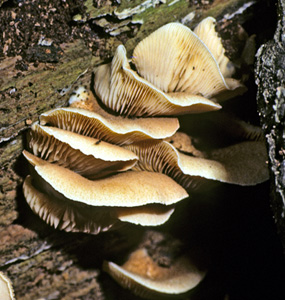Crepidotus mollis

Image Courtesy of Henry H. Mashburn
| Click to Enlarge |
| Click For Image Gallery |
|
Group of Fungi: Agarics Family: Inocybaceae Latin Name: Crepidotus mollis (Schaeff.) Staude Common Name: Jelly Crepidotus Description: Semicircular, shell-shaped to kidney-shaped structure, solitary or occurring in small clusters; cap 3/8–3 1/4 in (1–8 cm) across and 1/8–1/4 in (0.3–0.5 cm) thick (somewhat more at the point of attachment), upper surface orange brown to tan, smooth or with scattered small dark fibers, becoming gelatinous (hence the common name) when moist; gills moderately well separated, radiating outward from the point of attachment, white at first but becoming brown to reddish brown in age; stalk lacking; spores yellowish brown in mass. Biological Role: Decomposer of wood. Habitat: On the bark of fallen logs and stumps of broadleaf trees or (very rarely) conifers. Geographical Distribution: Widely distributed throughout North America. Comments: Fruiting bodies produced by members of the genus Crepidotus do not tend to be very conspicuous in nature. Other fungi that produce shell-shaped fruiting bodies with gills occur on decaying wood. However, Crepidotus mollis can be distinguished on the basis of its brown spores and somewhat gelatinous fruiting bodies. It is not considered to be edible. |
| Go Back |